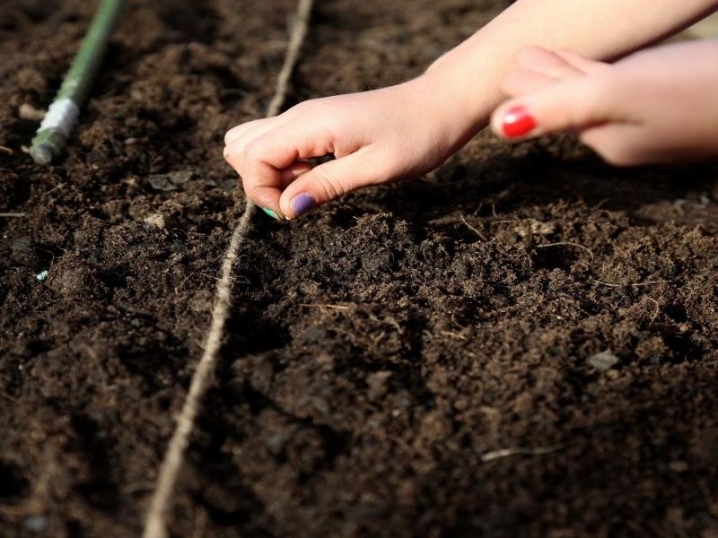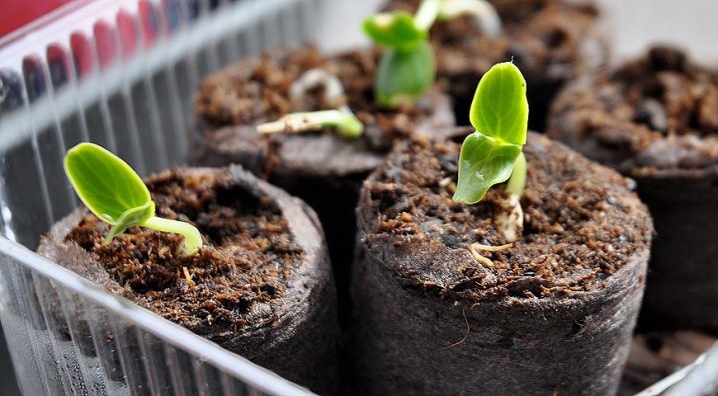How to grow mallow from seeds?

Mallow is a beautiful ornamental plant. It is very popular with gardeners and landscape designers. The plant can reproduce in several ways, including seed. However, it should be noted that, in comparison with other methods, seed reproduction is troublesome and not very fast.

What do seeds look like and how do you collect them?
The seed capsule of the mallow has a rounded and slightly flattened shape and consists of 5 sepals, under which are the seeds. The seeds are gray in color and have a double serrated edging, consisting of the smallest plates of wheat color. The seed diameter varies from 5 to 7 mm and depends on the plant variety.

During the ripening period, the sepals begin to acquire a yellow-brown color, but do not fully open. It is recommended to collect seeds during this period, tearing off slightly unripe capsules and placing them in a warm and dry place.
The air temperature in the room where the seed is located should be between 25 and 30 degrees. It is undesirable to leave unripe bolls on the stem, as they can be carried away by a gust of wind and there will be nothing to collect. After fully ripening, the sepals open, and the seeds ready for sowing spill out.
Mallow seeds are distinguished by good germination, which they retain for three years after harvest.

Moreover, according to experienced gardeners, the older ones, collected more than a year ago, have the best germination. When choosing a seed reproduction method, you should be aware that as a result of cross-pollination, many hereditary characteristics of the mother plant are lost, so young plants may have flowers of a different shape and color than that of the parent.
Cultures grown from seeds are often more decorative and have a very original color. It should also be borne in mind that the doubleness of the flowers with this method of reproduction is lost. At home, the seeds ripen quite quickly, after which they are cleaned of impurities, dried a little and removed to a dry place.
The ideal mode for storing seeds is a temperature of 10-15 degrees and an air humidity of no more than 50%.

Optimal disembarkation time
When propagating mallow by seed, you need to know the planting dates well. If it is planned to grow seedlings from seeds, then the best time for planting will be the end of February - the beginning of March. This time will be quite enough for young annuals to bloom already in the year of sowing. As for planting seeds in open ground, the event can be performed twice - in spring and autumn. It should be borne in mind that the plants of not only autumn, but also spring planting begin to bloom only the next year.
There are no clear dates for planting seeds in the spring, and each gardener determines the right time on his own. For example, in regions with a mild climate, planting begins as soon as the soil warms up above 10 degrees. This usually occurs in May, but in the south it occurs at the beginning of the month, and in more temperate latitudes in the middle.
In regions with a sharply continental climate, where the threat of return frosts persists throughout May, sowing is carried out in the last days of May or at the beginning of June. As for the autumn planting, the best time will be mid-September, and in the southern regions - early October.After planting the seeds, the garden bed must be mulched with fallen leaves, sawdust or peat and left to winter in this form.

Preparatory stage
Before you start sowing seeds, you need to decide on a place, prepare the land and select seeds.
Seat selection
Sowing mallow seeds in open ground involves choosing a permanent place, which is why this issue should be approached with full responsibility. It should be borne in mind that both annual and perennial species grow quite quickly and are quite tall plants. That's why planting is recommended to be done at a close distance from the fence or pergola, as strong winds can break the stems.
This, of course, will not lead to the death of the entire plant, but it will definitely deprive it of flowering. The area chosen for mallow should be well lit at any time of the day, otherwise the plants will start to stagnate and bloom poorly. Besides, the place must be protected from wind and drafts. To do this, you can build a man-made screen or choose a quiet place near a wall or fence.


The soil
Mallow is an unpretentious plant and not too demanding on the soil. This is due to the long root system of the flower, through which it receives nutrients from the lower soil layer. The best option for mallow is a light loam with a neutral pH level and a sufficient humus content. If clay prevails on the site, then a mixture of sand and humus, taken in equal parts, is added to it.
If sandy soils prevail, then the introduction of peat and clay is recommended.
The flower grows well on moderately moist soils, without stagnant water. Before planting seeds, the site is dug to a depth of 20-30 cm, weeds are pulled out and the missing components (humus, compost, sand, peat or wood ash) are added. If sowing seeds is planned for obtaining seedlings, then the substrate is bought in the store or prepared independently.
To do this, the garden soil is mixed with sand and humus in a ratio of 2: 1: 1, calcined in an oven at 200 degrees for 20 minutes. If this is not possible, then the soil mixture is spilled with boiling water or with a solution of potassium permanganate. This will help prevent the occurrence of such a dangerous disease for mallow as black leg.

Seedling container
When choosing a container for sowing mallow seeds, it must be remembered that the plant has long and very vulnerable roots, and therefore it needs tall peat pots.
When transplanting into open ground, the seedling is buried in the flower bed directly with the container, thus keeping the roots intact. If you use reusable containers or common seedling boxes, then when planting on a flower bed, most of the seedlings may die. If it is not possible to purchase peat pots, then the seeds are sown in high boxes with a depth of at least 10 cm.The distance between adjacent seeds should be 4-5 cm.

Seed preparation
When choosing a seed, you should know that using hybrid seeds is not recommended... This is due to the likelihood of the loss of many maternal traits in the second generation of flowers.
The best are seeds collected from varietal plants: they retain all information about the generic properties of a flower.
Before starting sowing, the seed material must be prepared, and this is especially true for one-year-old seeds. To wake up, it is recommended to leave them in warm water for 10-12 hours. This procedure helps to soften the seed coat and stimulates rapid germination.

How to sow?
Mallow seeds can be planted both in open ground and in seedling containers. The planting technology is so simple that even a novice summer resident can cope with it.
Sowing in open ground
Seed material is carefully laid out on a previously dug ground, after which it is sprinkled with a nutritious substrate.Some gardeners make shallow holes in the soil, where they place the seeds. The sowing scheme is as follows: the distance between two tall species of mallow should be 50-70 cm, between low-growing ones, such as mallow, is low - 45 cm. To obtain guaranteed seedlings, instead of one seed, it is better to plant three at once, placing them in a triangle at a distance of 5 cm from each other.

After sowing, the flowerbed is carefully moistened, trying not to wash the seeds out of the ground, and covered with agrofibre. Every day, the material is removed for 10-15 minutes and the planting is aired. Watering is done as needed, keeping the soil moist. The first shoots appear on the 14-20th day, depending on temperature conditions and care. After sprouting the sprouts, the film is removed, not forgetting to regularly water the planting.
If all the seeds have sprung up and the shoots grow too densely, they must be thinned out by transplanting the dug out shoots to another flower bed. However, due to the very vulnerable roots, there are no guarantees that the sprouts will take root. You should also know that when planting seeds in open ground, only annual species bloom in the first year.
Perennials, on the other hand, build up a leaf outlet, and begin to bloom only the next year.

Planting seedlings
Planting seeds for seedlings is the same as sowing in open ground. If a common box is used, then the seeds are placed at a distance of 5 cm from each other, sprinkled with a nutrient mixture and moistened with a spray bottle. Then the planting is covered with polyethylene and germinated in a bright place at a temperature of 20-22 degrees, watering and airing.
After the sprouts appear, which takes 10 to 12 days, the film is removed. Sowing seeds in peat pots is performed in the same way, with the only difference that glass jars or cut plastic bottles are used instead of plastic wrap. It is recommended to plant two seeds in each container.
After the young sprouts grow a little and get stronger, they begin to harden and prepare for transplantation to a permanent place. To do this, boxes or pots are taken out into the street, and every day they increase their time in the fresh air. Mallow tolerates picking very badly, therefore experienced gardeners recommend not to carry it out at all, or to plant only the largest and most powerful sprouts.
Young plants are transplanted to a permanent place at the end of May, after the threat of night frosts has completely passed. The transplant is performed very carefully, trying not to destroy the earthen lump. Seedlings from peat pots are planted together with the pots.

Correct follow-up care
Further cultivation of mallow seedlings requires traditional activities - watering, fertilizing, loosening, garter and mulching.
- Water the plant very sparingly., no more than twice a week and only after the topsoil dries up.
- When a hard crust appears the earth must be loosened, providing air flow to the roots.
- As a top dressing for adult plants, growing on depleted soils, you can use peat, humus or compost at the rate of 3 kg per 1 m2, or occasionally water them with a solution of wood ash. Organic matter should be applied after flowering, closer to autumn, and in the spring you can use ammophos or azophoska. For a more lush and long-lasting flowering, annual mallows are recommended to be fertilized with a complex of mineral fertilizers for flowering plants.
- Tall species often need a garter. To do this, a stake is placed next to the plant and a stem is tied to it with a soft twine. Dry leaves and wilted flowers are promptly cut off, thus increasing the flowering period.
- To retain moisture in the root zone, and also to prevent roots from freezing in winter, trunks are mulched with straw, spruce branches or peat.In the spring, the old layer is removed, replacing it with a new one.


For information on how to sow mallow, see the next video.







































































































The comment was sent successfully.